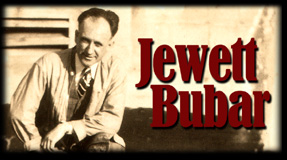Lobby Art
Starting about 1916 or so, Jewett Bubar began turning out large
(approximately 2' x 3') "lobby posters" for the latest
Hollywood films premiering in San Francisco. His outpouring was
as speedy as it was prolific. He is reported to have done as many
as 6 to 8 of these large rendering each week. Those shown here are
currently in the possession of his grandson, but other may still
exist.
Bubar began working for Paramount Pictures as a commercial artist
sometime during World War I. It was from his ground floor studio
behind the California Theatre
at 4th and Market Streets in San Francisco, that he began to turn
out a remarkable body of commercial artwork unique to the era.
One of his earliest efforts is a dramatic orange and blue poster
of the early silent Western star, William S. Hart. Hart's career
in Hollywood Westerns began in 1914 (His Hour of Manhood, The
Bargain). His rugged looks and masculine authority - so apparent
on the screen - are captured in Bubar's poster-paint representation.
|
|
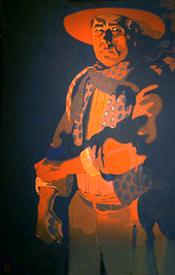
William S. Hart
|
|
Done in characteristically rapid fashion, Bubar would appear to
effortlessly produce 4 to 6 posters a week. His daughter indicates
that most of his posters and paintings were done freehand from the
numerous movie stills provided the artist from company press kits.
It is unclear when or what movie the Hart pose was taken from, but
It was probably painted before Hart's last silent Western (Tumbleweeds)
in 1925.
A later work that has also survived is that of a young Katherine
Hepburn, from the 1933 movie Morning Glory, for which she
earned her first Academy Award Hepburn had actually debuted a year
before - 1932 - in A Bill of Divorcement, opposite John Barrymore.
Bubar's daughter recalls that this poster was the product of Hepburn's
skyrocketing popularity at this time (two other Hepburn films from
1933 were Christopher Strong and Little Women). This
Morning Glory rendering was done completely in red chalk,
and is notable for its energy, shading, and remarkable highlighting
effects resulting from absence of chalkwork!
In all his years as a commercial artist, Bubar had a respect for
celebrities that could project both power and glamor - and he seemed
to have an affinity for capturing those qualities on canvas or poster
board.
|
|
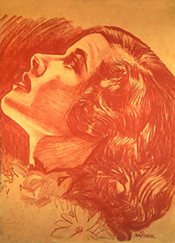
Katherine Hepburn
|
|
Not all Bubar's posters were of known actors or stars, however.
We see here another poster-paint work of one of the characters from
a movie entitled Moana of the South Seas (also known simply
as Moana). Bubar's daughter maintains that the head is merely
an atmospheric representation of any one of numerous possible characters
in the film, but it is possible that it represents the central character,
a young Polynesian named Moana.
Moana was produced by influential filmmaker Robert Flaherty,
shortly after the success of his famous Nanook of the North
(1922) which purported to chronicle the real-life daily life of
the Eskimos. The "documentary" (since called into question
for factual and ethical lapses by present-day standards), set the
mold for documentaries in the decades that followed.
Like Nanook, Moana was filmed on location (in this case,
the island of Savai'i in Samoa), and bears Flaherty's distinctive
poetic treatment of a realistic ethnographically-based subject.
The film took 2 years of location shooting, but never received the
acclaim that its predecessor had, though it, too, was arguably as
influential on future documentarians.
|
|
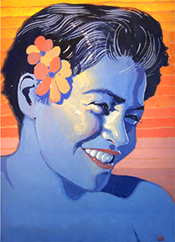
Moana Head
|
|
Another Bubar lobby poster that was known to still be extant as
recently as 1970, was that of silent screen actress Laura LaPlante.
This was another highly dramatic and stylized pose done in various
shades of greens and yellows, that probably dated from the late
'teens or early 1920's.
The image on this page is taken from a random snapshot that had
someone standing in front of the poster, his head just below LaPlante's
right hand, center. The image of the intruding head was "removed"
from the picture of the poster, and vague suggestions of the star's
clothing were substituted in Adobe Photoshop. Until the original
artwork is again located, this is all we have to document the work.
|
|
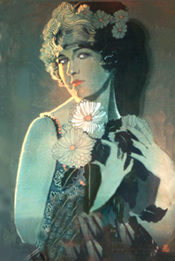
Laura LaPlante
|
Movie-Based Oil Paintings
Much of Bubar's early movie subjects were done on poster board using
the medium of poster paint. But towards the end of the 1920's, he
began to experiment in chalk (see Hepburn poster, above), and oil
paints.
Whereas his large lobby posters were rendered for public display
and were approximately 2' x 3' in size, the artist also created
several smaller oil paintings of movie stars and characters for
his own pleasure. One of the earliest extant of these film paintings
is of Anna May Wong - Hollywood's earliest Asian female star. This
oil dates to the late 1920's.
|
|
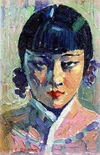
Anna May Wong
|
|
Ronald Colman was the subject of yet another personal "movie"
oil done by Bubar. Since Colman's career as swashbuckling leading
man roughly spanned the years between 1923 (The White Sister)
and the start of World War II (Lost Horizon and The Prisoner
of Zenda, both 1937), it is speculated that this portrait dates
from the early 1930's.
|
|
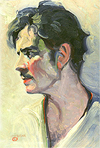
Ronald Colman
|
|
Probably taken from a movie still of unknown origin, a Native-American
Indian is the subject of this pose. Research is still being done
to determine the film from which this may have been taken.
|
|
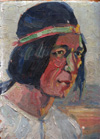
Native American Head
|
|
Similarly, this oil of an Asian Indian Sikh has the drama one might
expect from a movie still - again, of unknown origin. In this case,
however, the number of films dealing with South Asian subjects -
notably the British Raj in India - are fewer in number than American
Westerns during the period. Hopefully this shot can be traced to
Four Feathers (1939), Gunga Din (1939), or some other
production in the 1920's or 30's.
|
|
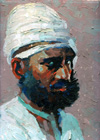
Sikh Head
|
| |
|
|
| |
|
|
|
